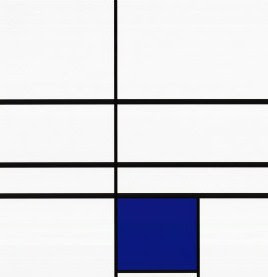Monet captured, utilized, mourned the tragic gap between the phenomenal and the noumenal. He stirred his hands childishly in appearances at the expense of reality. He mistook the apparent for the real. He discovered the reality of appearance. He preferred sensuous experience to objects because the sensuous is pleasant or easy or because he was too sophisticated or stupid or vile to appreciate permanent and fundamental values. Monet found wisdom in considered reflection on otherwise fleeting impressions. Monet needed glasses. Monet saw through the myth of the noumenal to the organizing function of human perception. He painted the very structure of the human brain. He painted souls.
What does Aunty say?
Monet painted pictures.
Sunday, November 1, 2009
Sunday, October 25, 2009
Gravity's Pull
An arch is thrown. Apex reached, it falls again. It can never transcend. Thrown at a building, with apex and wall in mutual support, the buttress is said to fly, though with obvious imperfection. The Romans too threw arch from column, allowing it to fall within a second column, then perhaps a third and more. They piled layers of arches over the first to raise the structure to a level at which a smooth, continuous motion could be maintained from one end of the aquaduct to the other. Long series of stacked interjections still fly over European valleys: failure latticed into glory, irresistibly flawed.
Sunday, October 18, 2009
From the Staffordshire Hoard
Its elements forever twined, interlocked, forcibly bent into a static social beauty, this and like stylings ring tragic with me. They bespeak not only the necessity of relation, but necessary relations. With those, the individual is made a node, and his creation, like the metalsmith’s, an accident of immanent utility. At least polyphony can be groaned, panted, beaten out in the subject’s precious time, even improvised. This bird cannot sing.
Sunday, October 11, 2009
Of Course
“So wild it was when first we settled here” –Thomas Hardy, Domicilium
I think of nature as whatever lives and happens in the absence of human agency. Culture at root refers to husbandry, the care of living, growing things. Somehow, the moment we cultivate them, things cease to be natural. People, the most artificial, the most cultivated, of beings, can go native, but this consists of no more than doing in Rome whatever Romans do. Unable to decide what to do, we are encouraged to do what comes naturally, meaning what occurs to us unbidden and without calculation. We answer nature’s call, on the other hand, with manufactured paper, molded porcelain and plumbed water. Where I come from, bidets are expensive and optional.
Not only does nature host our several growths, but each growth is said to have a nature. Yet not a single one of us can begin to describe what we were born to be, unless it were a howling, helpless infant. Paradoxically, human nature involves an element of indeterminacy. Adequately cultured, we might fulfill our better natures by actively and consciously shaping what we are, husbanding ourselves into what we want to be. People who manage this feat easily however, without paroxysm or paralysis, are said to be naturals. Maybe they're not people at all.
Sunday, October 4, 2009
Sunday, September 27, 2009
The Halo and the Punch
Consider 'The Man in the Golden Helmet', now thought to have been painted by one of Rembrandt’s school, rather than by the master himself. Portrayed is an old man, or a man old before his time, moustached, cheek scarred, eyes open though not fully, head tilted slightly downward and about 45° to his right. He wears a gilded and ornately decorated military helmet topped with feathers. A cheekguard hangs over the stiff collar of a tunic or breastplate.
The helmet is a badge of rank and thereby of honour and power. He had it specially made in his first proud flush of authority, or on his highest appointment. It was given to him as reward for victory, for miscellaneous services rendered, as a pledge of faith in his surpassing reputation, by his city, state or sovereign, by his commander, by his wife, by his father, by his troops. It was presented to him by a defeated general out of respect for his military art, his magnanimity, his noble soul. It was looted from a baggage train. The decoration depicts Achilles mourning Patroclus, Achilles avenging his dearest friend’s death, Achilles in his chariot dragging Hector’s body by its pierced heels around Troy’s moaning walls.
The man’s face is sternly set, evincing stoic discipline, its scars unfelt. A father remembers what his children will learn. A soldier meditates on impossible peace, on lost oportunities, on hollow glories, the finality of defeat. A clever man plots his next move. An officer pauses before a fateful command, a Rubicon to cross. A good man shoulders Christian shame for the sins of the world, or merely for his own. The man in the golden helmet must rule or be ruled. He listens unmoved to an underling’s report, he listens intently, he listens with gradually dawning dread, with boredom. Whatever he is looking at, he surely sees himself.
Wrought with skill and perception, a work of visual art can instantiate a sophisticated point of view, a fraught moral, a complex tale, revealing to its audience in the standard flash an argument the piecemeal articulation of which would take many sentences and please no eye at all. What is more, by showing rather than stating its wisdom, the piece retains both the concentrated punch of immediacy and the broader halo of ambiguity that equally inform its decisive moment. Now, it urges, choose.
Sunday, September 20, 2009
Content with Form
Let us short circuit the philosophers and define form as means or method of delivery. Content gets delivered. Undelivered content is unimaginable, since imagination itself is a means of delivery. Is an empty form possible, a void delivery? Even ‘Grey Field’ delivers a uniform colour within discretely framed two dimensional space, not to mention a title: Feldgrau was the colour of German army uniforms during the world wars.
If a representation delivers something that is conventionally recognizable, nothing we can slap on a wall, a plinth or a computer monitor will fail to represent. It might fail to represent lilies, or a prime minister, or the Christ’s passion, but it will speak at the very least of whatever it is. Something gets delivered; form is never empty.
The distinction of form from content is a propadeutic, its value exhausted by its utility. What carries meaning in one context is our subject in the next. To master this interchange of functions is to learn the art of saying something.
Sunday, September 13, 2009
Suspicion
Lost in ecstasy, we are insane. Locked in discipline, we are miserable. Yet measures of the two are anything but incompatible.
Discipline implies suspicion. People who control their drink are aware, almost invariably, of those who don’t. The sensitive see louts, the generous meet greed, the chosen or elect find the damned on every corner. It is often fear that drives our disciplines, but not always. Positive values too can bend us to effort and sacrifice. And suspicion.
Some people place a certain sort of experience at the top end of their scale of values, a rapturous and unlimited joy or sense of well-being. An ecstatic state or experience is decidedly undisciplined, and likewise removed from suspicion. But if no defined discipline or craft is necessary to the achievement of this experience, how does it differ from the bliss produced by opiates, mere smiling hap or manna? I prefer to think of joy as an achievement of craft and pleasure intermixed. It will be limited and compromised, but it will subsist. Of anything absolute, unlimited or easy, I am suspicious.
Sunday, September 6, 2009
The Tempest
Independent and bestaffed, our gentleman watches from a safe distance what might and might not be his child suckling at the breast of what might and might not be his mistress or wife. He might be enticed or repulsed, protective or careless, but he is certainly anxious. Of what? The woman is powerless, cemented to her biology and its offspring, and alone with both but for the interest, conscience or otherwise of her potential master. In this traditional idyll of father and flock, there is reason to fear. Any circumstance that denudes the woman and child of guidance and protection will destroy them, that prevents their guide from fulfilling his responsibility will ruin him, at least morally.
I’d like to think that Giorgione was enough of an artist to see past the obvious, to find poles within poles, as it were. The looming tempest of the painting’s background threatens to bookend the idyll itself with personal freedom, sexuality uncoupled from role, standing or conscience. Is it better to be cemented or alone? Some quiet mean would be sensible, but are not these the terms of our relational scale? There is no middle without ends. And of course there are more dimensions to this subject than two.
Saturday, September 5, 2009
The View from There

Without difference, nothing is the same. Without them, there is no me. Wrongs and rights generate each other as surely as inventions generate necessities. Likewise power and outrage, treasure and destruction.
Let's gander, at whiles, the little poles round which our tensions ease or thicken, the mincing logics of our local madness.
Taken in measure, something gives.
Let's gander, at whiles, the little poles round which our tensions ease or thicken, the mincing logics of our local madness.
Taken in measure, something gives.
Subscribe to:
Posts (Atom)











